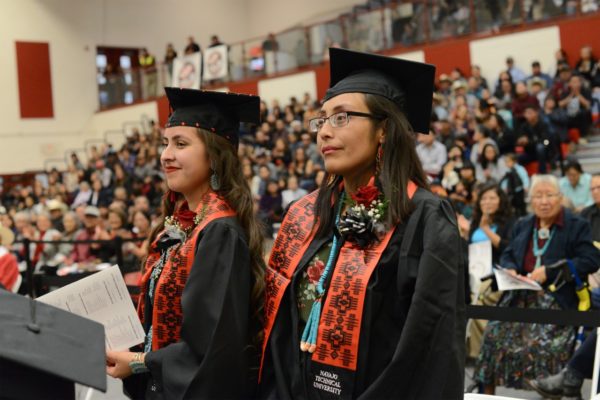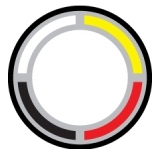
- Details
- By Native News Online Staff
CROWNPOINT, N.M. — Navajo Technical University students Selena Saunders of Continental Divide, NM and Krystal Louis of Crownpoint, NM made tribal college and university (TCU) history by becoming the first students to graduate as licensed veterinary technicians from a Veterinary Technology program accredited by the American Veterinary Medical Association (AVMA).
The students passed the licensure test, known as the Veterinary Technician National Exam (VTNE), in July 2019; however, certification is granted only when accompanied with a degree from an AVMA accredited program. Both students earned their degree on Dec. 13, 2019 at NTU’s fall commencement.
“I feel very happy about this and I’m excited. I feel like we’re on that path to graduating more students and really taking this program to the next level,” exclaimed Dr. Germaine Daye, who was hired in 2009 to head NTU’s Vet Tech and Lang Grant programs. “[Selena and Krystal] were two of the top students in their class. I have no doubt that in their careers, whatever task they take, they’re going to be well prepared.”
 Graduate Selena Saunders of Continental Divide, NM is adorned with a Registered Veterinary Technician pin at a pinning ceremony held at NTU’s Hospitality Center on Dec. 5, 2019.
Graduate Selena Saunders of Continental Divide, NM is adorned with a Registered Veterinary Technician pin at a pinning ceremony held at NTU’s Hospitality Center on Dec. 5, 2019.
NTU’s Associate of Applied Science degree program in Veterinary Technology was granted AVMA accreditation on its first attempt in March 2017, nearly 35 years after the program was first developed in 1983. The entire process took six years to complete, with two years devoted to gathering accreditation materials and evidence. Dr. Daye and her staff had to also revamp curriculum, improve classroom and research facilities, and balance coursework to include real world, hands-on experience and internships.
“It’s one of those things that doesn’t happen by itself. It takes a lot of hard work,” explained NTU President Dr. Elmer J. Guy at a pinning ceremony held for the students on Dec. 5. “I see Dr. Daye working late in the evenings dealing with animals and on weekends. She’s trying to build the next generation of veterinarians.”
Dr. Daye and her staff worked long hours preparing Saunders and Louis for the VTNE, dedicating nearly six and half weeks, eight hours a day going over test material. Two students had taken the exam when NTU first received AVMA accreditation, however, they waited two years after graduating and were unsuccessful. At the suggestion of NTU’s Veterinary Technology advisory board, students are now required to take the exam before they graduate, which to Dr. Daye, played a big part in the students’ success.
“We are proud of this tribal institution,” Navajo Nation President Jonathan Nez stated while in attendance for the pinning ceremony with Navajo Nation Division Director of Natural Resources Dr. Rudy Shebala. “We see great things happening here and I’m glad Dr. Guy has a vision for the Navajo people as well as this institution. The two students are reflecting the resilience of our people since time immemorial. I want to say thank you. There is hope.”
NTU’s Veterinary Technology program requires 73 credit hours with 54 hours of core veterinary technology instruction. Students are also required to take an Introduction to Veterinary Technology course that exposes students to the long hours required of veterinary technicians. In the course, students have to complete 20 hours assisting in community veterinary services, 30 hours assisting at the NTU teaching hospital, 30 hours of on-call duties providing animal care, 6 hours doing presentations at regional K-6 schools, and 3 hours doing outside veterinary volunteer work.
In addition to being joined by President Nez and Dr. Shebala, NTU also welcomed three of the Veterinary Technology program’s seven advisory board members. The board members in attendance included Dr. Terry Clark of North Carolina, Dr. Gregory Gaj of Florida, and Dr. Janet Payeur of Iowa.
For more information about NTU’s AVMA accredited Veterinary Technology program, contact Dr. Germaine Daye at [email protected].
More Stories Like This
Navajo Council Committee Advances Legislation to Authorize $30 million in Recurring Annual Funding for Tribal Higher Education & ScholarshipsNTU Launches Fast-Track Construction Trades Program
Native Forward Scholars Fund Announces 2025 Students of the Year at Empowering Scholars Summit
Navajo Nation Speaker Curley and Council Delegate Dr. Nez Join Education Leaders to Address Federal Budget Cuts
Mackie Moore (Cherokee) Named Interim President of Haskell Indian Nations University
Help us tell the stories that could save Native languages and food traditions
At a critical moment for Indian Country, Native News Online is embarking on our most ambitious reporting project yet: "Cultivating Culture," a three-year investigation into two forces shaping Native community survival—food sovereignty and language revitalization.
The devastating impact of COVID-19 accelerated the loss of Native elders and with them, irreplaceable cultural knowledge. Yet across tribal communities, innovative leaders are fighting back, reclaiming traditional food systems and breathing new life into Native languages. These aren't just cultural preservation efforts—they're powerful pathways to community health, healing, and resilience.
Our dedicated reporting team will spend three years documenting these stories through on-the-ground reporting in 18 tribal communities, producing over 200 in-depth stories, 18 podcast episodes, and multimedia content that amplifies Indigenous voices. We'll show policymakers, funders, and allies how cultural restoration directly impacts physical and mental wellness while celebrating successful models of sovereignty and self-determination.
This isn't corporate media parachuting into Indian Country for a quick story. This is sustained, relationship-based journalism by Native reporters who understand these communities. It's "Warrior Journalism"—fearless reporting that serves the 5.5 million readers who depend on us for news that mainstream media often ignores.
We need your help right now. While we've secured partial funding, we're still $450,000 short of our three-year budget. Our immediate goal is $25,000 this month to keep this critical work moving forward—funding reporter salaries, travel to remote communities, photography, and the deep reporting these stories deserve.
Every dollar directly supports Indigenous journalists telling Indigenous stories. Whether it's $5 or $50, your contribution ensures these vital narratives of resilience, innovation, and hope don't disappear into silence.
 The stakes couldn't be higher. Native languages are being lost at an alarming rate. Food insecurity plagues many tribal communities. But solutions are emerging, and these stories need to be told.
The stakes couldn't be higher. Native languages are being lost at an alarming rate. Food insecurity plagues many tribal communities. But solutions are emerging, and these stories need to be told.
Support independent Native journalism. Fund the stories that matter.
Levi Rickert (Potawatomi), Editor & Publisher

